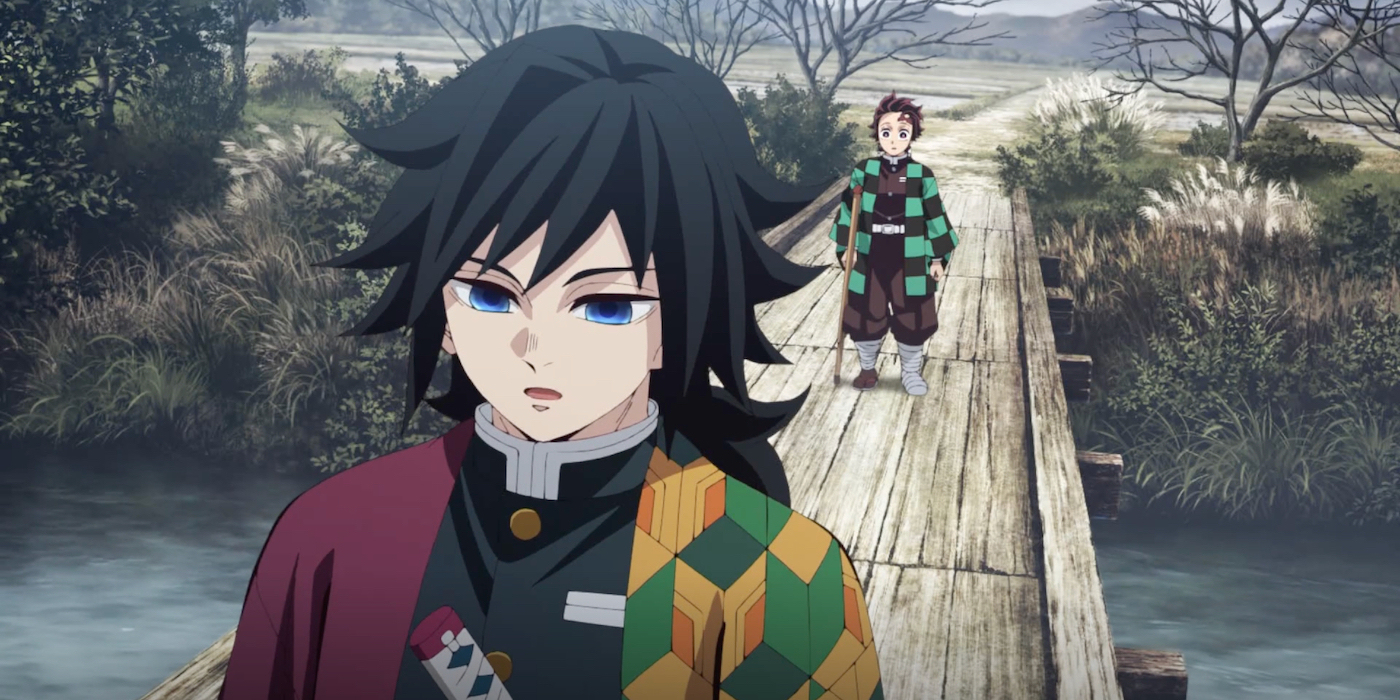
This Demon Slayer review contains spoilers.
“Don’t bother with me. You’re just wasting your time.”
Demon Slayer: Kimetsu no Yaiba, despite its action-packed focus, has always been an incredibly emotional series. Inner demons have just as much power over the heroes as the literal ones who threaten their lives. Demon Slayer’s “Hashira Training Arc” season focuses on all-out Demon and Hashira warfare. This means that the Demon Slayer Corps. need all the help that they can get, including cooperation from their most passive members, like Giyu Tomioka.
“Water Hashira Giyu Tomioka’s Pain” is all about dealing with one’s past trauma, the acceptance of guilt and loss, and learning how to move on and transform this pain into productive energy. This is a lesson that Tanjiro has had to learn several times over – most recently through the loss of Kyojuro Rengoku – but it proves to be a much harder and more visceral process for Water Hashira, Giyu Tomioka. So much of Demon Slayer’s Hashira Training Arc is prepared to focus on improving individuals’ physical strength, sword skills, and breathing techniques so that they can earn their Hashira marks and survive against Muzan Kibutsuji’s assault. However, “Water Hashira Giyu Tomioka’s Pain” and its emphasis on raw grief proves that Tanjiro can be just as much of a helpful teacher as he is a dutiful student. After all, as Lady Tamayo says, “only immatures can’t control their emotions.”
“Water Hashira Giyu Tomioka’s Pain” may seem like a muted entry that’s relatively small stakes in nature – a Hashira needs to reckon with his past and learn how to once again pick up his sword – but there’s arguably nothing more important than such a struggle. Tanjiro wouldn’t even be with the Demon Slayer Corps. right now if he didn’t learn how to process his pain and channel it into strength.
It’s a smart way to kick off this season after a very exposition heavy and table-setting premiere that was more interested in laying out this chessboard than actually making its first move. There’s a welcome focus on Tanjiro after he spent most of the season premiere, “To Defeat Muzan Kibutsuji,” in recovery mode. That being said, his mission in this episode has less to do with his improving upon his Hashira skills, but rather his ability to help a fellow Demon Slayer get their groove back and reawaken their killer instinct.
Giyu Tomioka is a natural loner, but this is a time where the Hashira need to band together and work as a singular tool of destruction. “Water Hashira Giyu Tomioka’s Pain” deconstructs the idea of how to make someone who wants to be left alone feel supported and loved. It’s determined that Tanjiro is the ideal person for this tall task, but he approaches this mission with extreme caution and respect.
It’s clear that Tanjiro carries incredible admiration towards Giyu and doesn’t want him to regress or unintentionally push him to an even worse place. “Water Hashira Giyu Tomioka’s Pain” gets a lot of mileage out of Tanjiro and Giyu’s contrasting personalities, right down to the simplified and comical expression that’s painted across Tanjiro’s face for most of the episode’s first act as he pesters Giyu. It’s a fun visual gag in what’s otherwise a very dark and dreary Demon Slayer episode.
The contrast between these two characters becomes even more striking when Giyu dons the same blissed out look, alongside Tanjiro, by the episode’s end. They gleefully enjoy soba together, as friends, and their unity means considerably more after seeing how distant they were when the episode begins. Giyu no longer feels alone, but he also gains a genuine companion who helps him heal his wounds.
There’s also some welcome symmetry to how Tanjiro’s intrusive behavior makes Giyu feel like he’s being haunted by a spectre, all before the audience learns that he is in fact encumbered by a heavy past that he carries with him at all times, unable to shake off. The unwanted attention that Tanjiro heaps on Giyu mirrors his painful memories of Sabito.
Demon Slayer loves to indulge in sad backstories – particularly with the circumstances that surround its Demons – and it’s become one of the anime’s most signature elements. Demon Slayer has worked hard to make sure that these unexpected emotional avalanches don’t begin to feel like a parody of themselves, even if it’s gotten quite close to this point. There’s a definite balance to these types of stories and they run the risk of losing their impact when they’re so plentifully indulged upon. Demon Slayer creates even higher stakes for these painful backstories when they correspond to a main character and have irrevocably changed their trajectory.
“To Defeat Muzan Kibutsuji” previously established that Giyu Tomioka doesn’t believe that he deserves the Water Hashira title and that he harbors a terrible secret. This is a great place to begin an episode, but it also means that Demon Slayer has to stick the landing and feature a tragedy that’s fitting of the pedestal that it’s been placed upon. What Tomioka reveals isn’t necessarily Earth shattering, but it’s genuinely devastating character development that’s worthy of the tears that it conjures.
Tanjiro had his own experience with Sabito during his Hashira Final Selection trial. However, Sabito and Giyu – at the young age of 13 – were both subjected to their own Final Selection test where they accrued heavy battle scars that continue to act as throbbing reminders of the past. Sabito fearlessly saved Giyu’s life and demonstrated impressive Water Breathing proficiency against the hateful Hand Demon, only to ultimately perish by the exercise’s end. Giyu feels guilty for somehow passing the Final Selection, considering that he didn’t kill a single Demon during the test, and that he’s a fraud who’s unfairly claimed Sabito’s title.
To some extent, Giyu sees himself as living the life that’s meant for Sabito and this fills him with an overwhelming sense of imposter syndrome. Giyu feels remorse and shame with every swing of his blade, yet Tanjiro helps him understand that his ability to live a rich life means that Sabito never has to be truly gone. His memory and purpose will live on through Giyu. This may seem like a fairly pat and obvious resolution, but one has to imagine that Giyu isn’t the most reflective or introspective individual. This philosophy isn’t as clear to him as it is to the audience.
“Water Hashira Giyu Tomioka’s Pain” briefly explores whether Tanjiro should replace Giyu as the Water Hashira or if he should stay on the path that he’s been forging from the series’ start. The latter of which also allows Giyu to triumphantly reclaim his destiny instead of shrinking into the shadows. It’s interesting to see Demon Slayer present Hashira titles as being in flux and elements that have the potential to change over the course of the series as their respective Hashira continue to evolve.
There’s a lot of value in this idea and Demon Slayer’s final battles could become even more unpredictable and exciting if Hashira utilize multiple breathing styles. That being said, Giyu’s interest in Tanjiro taking over the Water Hashira title feels temporary and directly related to his own ambivalence rather than something that will be an ongoing struggle for Tanjiro.
“Water Hashira Giyu Tomioka’s Pain” is almost exclusively centered around Giyu’s suffering. However, the episode is bookended with compelling material that teases the season’s grander storyline. Lady Tamayo , a skilled Demon doctor, apprehensively agrees to enter the belly of the beast and begin work within the Demon Slayer headquarters. Tamayo is feared for her blood-thirsty nature, but it’s her incredible intellect that’s necessary to help reverse-engineer Nezuko’s condition, create a sun cure, and figure out what’s truly going on here.
It seems as if Demon Slayer is going to drag out these developments piecemeal, but it’s still encouraging to already be getting some momentum on this front as the Hashira reinforce themselves. Shinobu Kocho’s festering trauma over the Demon who killed her sister, Kanae, also adheres to the same themes that plague Giyu throughout this episode. It’s a helpful reminder that the most capable and care-free Hashira still harbor trauma and deep scars, even if they’re not visible like the ones on Giyu. Recovery, forgiveness, and peace are a life-long process. Hopefully, at some point, Giyu will reach a point where he’s able to make it look as easy as Shinobu does.
Part of what makes Demon Slayer’s latest season so much fun is that its episodes spend time with not only new characters, but the world’s most powerful Hashira. Demon Slayer’s Hashira Training Arc establishes a strong precedent on this front with the work that it does with Giyu Tomioka. Not every episode can follow this formula, but it’s exciting to consider what lies ahead when Demon Slayer begins to pull back the layers on the rest of these hardened characters, especially those who have been shrouded in even greater mystery, like Gyomei Himejima.
“Water Hashira Giyu Tomioka’s Pain” is a slow and methodical episode that continues the season premiere’s more laid back tone, despite the impending Hashira war that lies ahead. Some fans may miss the heightened hacking-and-slashing action that’s become Demon Slayer’s trademark. However, those who appreciate the anime’s rich ability to develop realistic, conflicted characters will not be disappointed. Episodes like “Water Hashira Giyu Tomioka’s Pain” are necessary for the rest of the season to work.
There’s still plenty of time for heads to roll.
The post Demon Slayer Season 4 Episode 2 Review: Water Hashira Giyu Tomioka’s Pain appeared first on Den of Geek.





